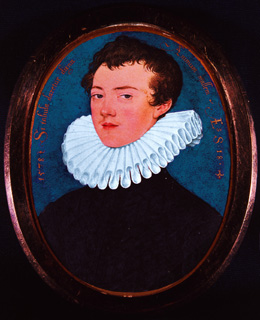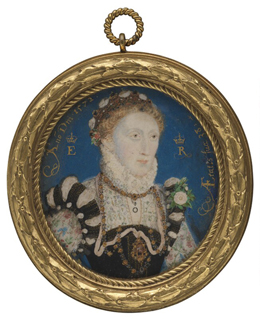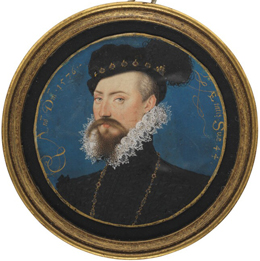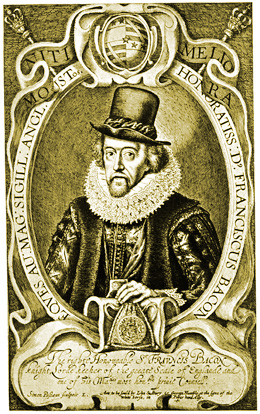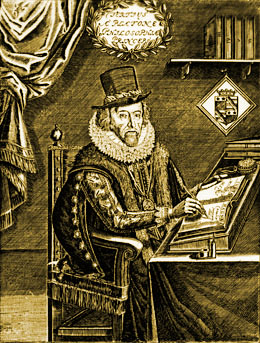Royal Birth
“In which sort of things it is the manner of men, first to wonder that such a thing should be possible, and after it is found out, to wonder again how the world should miss it so long.”
Francis Bacon: Valerius Terminus
Francis Bacon, Son of Queen Elizabeth I
A summary of evidence pointing to Francis Bacon being the eldest living son of Queen Elizabeth I, but adopted by Sir Nicholas and Lady Anne Bacon.
The Vestal Flame Portrait of Elizabeth I
In this engraved portrait of Queen Elizabeth I from De Larray’s Histoire de I’Angleterre, d’Ecosseet d’Irlande (Rotterdam, 1707), the secrets of Elizabeth’s motherhood are openly disclosed. Portrayed with the Queen are three children who are shown as her progeny. One is in the background, in the shadows, and depicted shrouded and dowsing the vestal flame. This is clearly meant to signify the Queen’s first-born—a child who was either still-born or died early, and who was the result of her first sexual affair that took away her virginity. The other two are in the forefront, in the light, endowed with symbols that declare exactly who they are—namely, Francis Bacon (22 January 1561 – 9 April 1626), the elder of the two, and Robert Devereaux (10 November 1565 – 25 February 1601), who was almost five years younger. Both are shown as sons of the Queen, and either one could have been heir to the throne of England had the Queen publicly named him as such. According to the primogeniture law of succession, the eldest son, Francis Bacon, would have been the one entitled to be named as heir—and, when Essex died before the Queen, there was no other option anyway. But, in the end, the Queen did not acknowledge any of her sons.
► For more detail, pictures and references, see ‘The Vestal Flame Portrait of Elizabeth I.
The Natural Issue of her Majesty’s Body
In 1571 Parliament passed an Act of Treason in which it was “established and affirmed” that the “right Heir and Successor” to the Queen’s Majesty should be “the natural issue of her Majesty’s body”. Both the 1543-4 Act of Succession and the previous 1533-4 Act of Succession refer to “the heirs” of Lady Elizabeth’s body being “lawfully begotten”, so this 1571 change of wording caused many people to believe that the Queen could name a bastard of hers (i.e. a child born out of marriage) as well as a child of hers conceived as a result of marriage (i.e. “lawfully begotten”) as the heir to the throne of England. In fact, “lawfully begotten” still legally applied, unless the Queen, following in her father’s autocratic footsteps, further changed the law, or reinterpreted it to suit her wishes, and compelled Parliament to agree. However, as it was left, the Queen had the sole right to name as her heir to the throne of England any “natural issue” (i.e. child) of hers, howsoever begotten, but to do so she would probably also have had to declare that she was or had been secretly married and that the named heir was therefore lawfully begotten.
For many people, the implication of the word change was that the Queen had probably made a secret marriage and that, at any time of her choosing, she could declare that she had been secretly married and produce evidence to that effect. That this was the case is evidenced by three reputable sources:
- The historian William Warner announced, in his 1612 edition of Albion’s England, that Queen Elizabeth I had concealed her heir, the Prince of Wales.
- The historian and herald, William Camden, named Leicester as the father of the Queen’s offspring in his Annals of Queen Elizabeth’s reign, published in 1615.
- Francis Bacon, in his Collection of the Felicities of Queen Elizabeth, pointedly likens Elizabeth to Alexander the Great and Julius Caesar, both of whom had no named issue in terms of succession, but who did have children.
► For more detail and references, see ‘The Natural Issue of her Majesty's Body’.
The Affair of Thomas Seymour and Princess Elizabeth
When Henry VIII died on 28 January 1547 and Edward VI became king at age nine, Edward Seymour, 1st Duke of Somerset, became the Lord Protector. His brother, Thomas Seymour, likewise an uncle of Edward VI, was created 1st Baron Seymour of Sudeley and made Lord High Admiral. Soon after, in April or May 1547, Thomas Seymour secretly married Catherine Parr, Henry VIII’s widow, with whom he had had an affair prior to her marriage with Henry VIII. He then moved into his wife’s house, Chelsea Manor in London. Living there with the Dowager Queen and under her guardianship was her step-daughter, the 13-year-old Elizabeth, half-sister of Edward VI.
Within days of Seymour’s arrival, Elizabeth started to receive early-morning visits from him. To begin with, he engaged in romps and horseplay with the young teenager, which included entering her bedroom in his nightgown, tickling her and slapping her on her buttocks as she lay in bed; but this developed further. Eventually, in the spring of 1548, when a now-pregnant Catharine discovered her husband and Elizabeth embracing each other, she sent Elizabeth away to live with Sir Anthony Denny and his wife, Joan Champernowne, Kat Ashley’s sister, at Cheshunt in Hertfordshire.
Throughout that summer, whilst living at Cheshunt, Elizabeth was reported to be ill with migraines, jaundice, digestive problems and irregular menstruation. When Catherine Parr died shortly after childbirth on 5 September 1548, Thomas Seymour resumed his attentions to Elizabeth by letter, planning to marry her. Even Kat Ashley, Elizabeth’s governess and close friend since 1537, sought to convince Elizabeth to take him as her husband. Elizabeth, by now a 15-year-old teenager, was receptive, but unready to agree to anything unless permitted by the Council.
In January 1549, Thomas Seymour was arrested and imprisoned in the Tower on suspicion of embezzlement, conspiring to depose Somerset as the Protector, kidnap the King, marry Princess Elizabeth without the Council’s consent, and make himself de facto king as the Lord Protector. He was condemned by an Act of Attainder and beheaded on 20 March 1549.
When Thomas Seymour was arrested, Somerset sent Sir Robert Tyrwhit to Hatfield, to question and extract a confession from Elizabeth, whilst her closest companions—her cofferer, Thomas Parry, and her governess, Kat Ashley—were taken to London for questioning. Although interrogated for weeks, Elizabeth admitted nothing incriminating, so that all that her interrogator, Sir Robert Tyrwhitt, could report was, “I do see it in her face that she is guilty”. Likewise, Kat Ashley revealed nothing treasonous.
Suspicions nevertheless abounded that, in 1548, Seymour had made Elizabeth pregnant, and that the princess had then either aborted the child or the child was still-born.
► For more detail and references, see ‘The Affair of Thomas Seymour & Princess Elizabeth’.
The Affair of Robert Dudley and Queen Elizabeth I
Robert Dudley (1532-1588) and Princess Elizabeth (1533-1603) had been friends since 1541. As he would write much later in life, “I have known her better than any man alive since she was eight years old.”
Following the turbulent events of 1549-1554, Robert and Elizabeth were, for different reasons, prisoners in the Tower of London, where a special liaison between them was said to have taken place. Robert had been there since 25 July 1553, as a result of being involved with his father and brothers in the installation of Lady Jane Grey on the throne of England. Elizabeth was sent to the Tower on 17 March 1554, under suspicion of being involved in a plot to depose Mary and install Elizabeth on the throne of England. Despite her innocence in the matter, she was kept a prisoner in the Tower for two months. Whilst there, according to hearsay reports, she and Robert Dudley contrived (with the help of a jailer) to meet up surreptitiously and go through some form of marriage or marriage betrothal, as the threat of imminent execution haunted them daily.
On 17 November 1558 Queen Mary died and Elizabeth acceded to the throne of England. The following morning, 18 November 1558, the surrender of the Great Seal to Queen Elizabeth took place at Hatfield. One of the witnesses was Robert Dudley, who was made Master of the Horse on the same day. This was a highly important court position entailing close attendance on the sovereign. It not only made him the only man in England officially allowed to touch the Queen, but also the quarters allotted to him were in rooms adjoining the Queen’s bedchamber.
To keep her country and Parliament happy, and foreign nations happy, the Queen began a policy of negotiating possible marriages with suitable foreign princes, or intimations of possible marriage with leading high-ranking countrymen; but this was all for show, to keep the peace, maintain her personal safety and that of the country, enhance her regal authority and autocratic control, and provide a cover for her own real desires and behaviour. Her real desire was for Robert Dudley, whom she kept close to herself at all times. As reported by various people, including foreign ambassadors and spies, the couple were very intimate and in love with each other, with the Queen visiting Lord Robert in his chamber day and night, and never letting him leave her.
On St George’s Day, 23 April 1559, the Queen created Robert Dudley a Knight of the Garter, and bestowed on him land and gifts. From that time onwards the Queen’s notably intimate relationship with Lord Robert began to attract more wide-spread comment, and suggestions were made, and reported by ambassadors, that if Lord Robert’s wife were to die, the Queen intended to marry him. There were reports that Amy Robsart, Lady Dudley, was ill; also, that Lord Robert intended to divorce her.
In May 1560, whilst Sir William Cecil, the Queen’s Secretary of State, was away in Scotland to negotiate the Treaty of Edinburgh, Elizabeth and Robert Dudley made the most of their freedom, with the Queen refusing to attend to any matters of state. The couple spent every day closeted up together, so much so that it was widely commented on and reported that the Queen’s health was suffering. The result, not surprisingly, was that Elizabeth had become pregnant. Naturally, the condition did not go unnoticed. The story that the couple were lovers and that Elizabeth was pregnant spread across the country.
Then, on Sunday 8 September 1560, Amy Robsart was found lying dead at the foot of the staircase to her chamber in Cumnor Place, with her neck broken and two wounds on her head. The finding of the coroner’s jury afterwards was that it was a “misfortune”—an accidental death brought about as a result of falling downstairs, sustaining two head injuries and breaking her neck.
The tragic incident caused a commotion in both the court and the country. Murder and suicide were each contemplated as possible alternatives to the jury’s official statement of “misfortune”, with the general belief being that either Dudley or Elizabeth, or both, had engineered Amy’s death, or that she was murdered by persons who hoped to profit by Dudley’s now expected marriage to the Queen, or, contrariwise, who hoped to prevent the marriage of Dudley and the Queen. Whatever the cause of Amy’s death, because of what people thought, it now made any public marriage of the Queen and Dudley well-nigh impossible.
► For more detail and references, see ‘The Affair of Robert Dudley and Queen Elizabeth’.
Queen Elizabeth I’s Pregnancy, Secret Marriage and Childbirth
In November 1560 the Queen’s “looks” were quite consistent with a pregnant woman, and in December 1560 a secret despatch among the Escurial Papers said that the Queen was expecting a child by Robert Dudley. In early 1561, it was reported that Elizabeth was bedridden with a mysterious illness that caused her body to swell. In addition, there were rumours that a formal betrothal had already been made privately between the Queen and Robert Dudley.
Various ambassadors reported these rumours. As the months passed, their reports became increasingly more certain that the Queen was indeed pregnant and that Dudley was the father. By the end of December, they were reporting that, according to rumours, the Queen and Dudley had been secretly married. In January 1561 the Spanish Ambassador, De Quadra, reported to the King of Spain that a marriage between the Queen and Dudley was now “in everybody’s mouth”, and Dudley had said that if the King of Spain would countenance the marriage, they would restore the Catholic religion.
According to the Dictionary of National Biography, “on Jan. 21 1560/1 Queen Elizabeth was secretly married to Robert Dudley in the House of Lord Pembroke before a number of witnesses.” Even William Cecil, the Queen’s Secretary of State, when challenged, did not deny it. On 22 January 1561, according to William Rawley, Francis Bacon was born to Sir Nicholas and Lady Anne Bacon, either at York House or York Place. York Place, also known as Whitehall, was the Queen’s palace.
After this there were reports and rumours that the Queen was now a mother. The 1895 edition of British Dictionary of National Biography even states, from the all the evidence compiled by the historian Mme Amelie Deventer von Kunow, that: “Whatever were the Queen’s relations with Dudley before his wife’s death, they became closer after. It was reported that she was formally betrothed to him, and that she had secretly married him in Lord Pembroke’s house, and that she was a mother already.” The Earl of Pembroke’s town house was Baynard’s Castle in London. This would have been William Herbert, 1st Earl of Pembroke.
In October 1562, when Queen Elizabeth fell ill with smallpox, she asked the Privy Council to make Robert Dudley Protector of the Realm. However, she made a quick recovery and the plan was not enacted. Dudley was instead made a privy councillor. In June the following year the Queen granted him Kenilworth Castle, Manor and Park, together with the lordships of Denbigh and Chirk in North Wales, and in September 1564 she created him Earl of Leicester.
In 1563 the Queen asked the great scholar Roger Ascham, who had served as private tutor to herself when a princess, as well as to her brother, Edward VI, and to Robert Dudley, to write a book concerning the education of young noblemen. To preface it, Ascham wrote a dedication to the Queen, entitled Divae Elizabethae, written as a personal letter to the Queen and dated 30th October 1566. The book, titled The Schoolmaster, was finished in 1566 but not published until 1571, three years after Ascham’s death and with the dedication omitted.
The dedication eventually came to light in 1761, when it was first published by James Bennet. In this dedication, Ascham shows that he is intimately conversant with Elizabeth’s secret private life by likening it to that of David, King of Israel, and singling out in particular the sin of David with respect to Uriah, whose death David brought about in order to marry Bathsheba. The sin of David with Bathsheba resulted in the birth of a son. It was further compounded by David sending Uriah, the husband of Bathsheba, to his death in battle so that David could marry the pregnant Bathsheba.
► For more detail and references, see ‘Queen Elizabeth I Pregnancy, Secret Marriage and Childbirth’.
Sent from the Queen’s Hand
In September 1576 Francis Bacon, aged fifteen, was sent to France “from her Majesty’s royal Hand”, which meant that he went with the Queen’s direct authority and blessing and by her command. For someone still so young, this was not only a privilege but also an extraordinarily unique thing for the Queen to have done. This in itself indicates that the teenage Francis was someone who was considered of extra-special importance to the Queen, as well as now being completely included in and dedicated to her service, as indeed one would expect of a first-born son and potential heir to the throne. Before this occurred, there are some possible indications that this was so.
► For more detail and references, see ‘Sent from the Queen's Hand’.
Hilliard Portrait of Francis Bacon
In 1578 a miniature portrait of Francis Bacon was painted by Nicholas Hilliard, the English portrait miniaturist and Queen Elizabeth I’s official limner (miniaturist), when both Francis Bacon and Nicholas Hilliard were in Paris. The portrait must have been done before October 1578, as Hilliard returned to England that month, which means that Francis Bacon, who was born 22 January 1561, was in his 18th year of age.
In Hilliard’s miniature, Francis Bacon is shown with features similar to those of the Queen in Hilliard’s miniature portrait of Elizabeth made in 1572, whilst Francis’ dark brown curly hair is similar to that of Leicester. Moreover, Francis’ dark brown eyes are the same colour as those of both the Queen and Leicester, and are not the blue-grey eyes of Sir Nicholas and Lady Anne Bacon.
Far more noteworthy, however, than the difference in eye colour, the importance of which is debatable, is the fact that there is no record nor even any evidence of Hilliard ever having painted Sir Nicholas Bacon or Lady Anne Bacon or Anthony Bacon, which one might have expected, seeing as he painted Francis, the (supposed) younger son of the family. Instead, Queen Elizabeth, the Earl of Leicester and Francis Bacon were portrayed in a set of similar miniatures by the Queen’s official limner, who had been introduced to the Queen by Leicester, and it was the Queen who had sent Francis Bacon to France in 1576 “by her hand”.
By contrast, Sir Nicholas Bacon had a set of painted terracotta busts made of him and his second wife, Lady Anne (née Cooke), and of their son Anthony Bacon. The three busts were made c.1566, to be displayed in Sir Nicholas and Lady Anne’s newly-built family home of Gorhambury House, near St Albans. The busts show Sir Nicholas Bacon aged c.58 years, Lady Anne Bacon aged c.35 years, and Anthony Bacon aged c.7-8 years old. Anthony was Sir Nicholas and Lady Anne’s first-born son, so it was natural that he should have been sculpted as part of this family set; but, notably, no bust was made of Francis Bacon, who would have been aged 5 at the time.
As a result of the Queen’s visit to Gorhambury in August 1568, during which the Queen had remarked to her Lord Keeper, “My lord, what a small house you have gotten,” Sir Nicholas Bacon set in motion the building of a Long Gallery extension to the main house. Sir Nicholas then had the set of three family busts carefully and prominently placed in the Long Gallery, in readiness for the Queen’s second visit to Gorhambury in July 1572. But still there was no bust of Francis Bacon. The omission is startling, and pointedly suggests that Francis was not the Bacon’s natural son, and that the Queen knew this.
► For more detail, pictures and references, see ‘Hilliard Portrait of Francis Bacon’.
Being thus born in the purple
The first biography of Francis Bacon (Discours sur la Vie de Mre. Francois Bacon, Chancelier d’Angleterre), authored by Pierre Amboise and published in France in 1631, contains some enigmatic details, such as the statement that Francis Bacon’s ancestors “left so many marks of their greatness in history that honour and dignity seem to have been at all times the spoil of his family”, and that he was “born in the purple and brought up with the expectation of a great career”.
However, Amboise’s reference to Francis Bacon’s ancestors having “left so many marks of their greatness in history that honour and dignity seem to have been at all times the spoil of his family” is simply not true in terms of Sir Nicholas Bacon’s ancestors. Sir Nicholas came of humble stock who left no marks of greatness in history. The same can be said for Lady Anne Bacon’s ancestors. Amboise’s description of the family’s honour, dignity and greatness in history is more suited to a description of a prominent noble or royal line of decent.
Moreover, Amboise’s remark that Francis Bacon was “born in the purple” also needs questioning. This is an idiom with specific legal meaning, referring to royal birth. By the time of Amboise’s writing, the idiom was beginning to be more loosely used to also include anyone born of a highly prominent, high-ranking parent. However, in England, according to a law passed by Act of Parliament in 1464, commoners were not permitted to wear purple, and Sir Nicholas Bacon and his wife Lady Anne (nee Cooke) were commoners and not nobility, even though Sir Nicholas was addressed as “Lord Bacon” by virtue of the office he held as Lord Keeper of the Great Seal. The Queen had intended to raise Sir Nicholas to the aristocracy, but he died before she had carried out her intention.
Moreover, when Francis Bacon married in 1606, he was “clad from top to toe in purple”. This was something reserved by law to the royal family of England only. Nobles could wear a certain amount of purple in their clothing, the amount being dependant on rank, but they were not allowed to wear purple from top to toe—and the law was rigorously applied.
Francis Bacon repeated this again when he was appointed Lord Keeper of the Great Seal by King James I of England, VI of Scotland. Having appointed Bacon to this high office on 7 March 1617, King James immediately left his Lord Keeper to act as his temporary regent in England whilst he departed for Scotland for a six-month visit. In the King’s absence, Lord Bacon took his place in Chancery with magnificent ceremony and dressed in purple satin from top to toe, just as he was on his wedding day.
In both instances King James never complained or brought Francis Bacon to account for this apparent breaking of the law and blatant portrayal of himself as being of royal blood. This begs the questions: Why did the King and the authorities allow this? What secret did King James know?
► For more detail and references, see ‘Francis Bacon, born in the purple’.
Your Sovereign Francis
That others knew of Francis Bacon’s royal birth and the fact that he was the Queen’s eldest surviving son and therefore the primary heir to the English throne if his mother, Queen Elizabeth I, ever chose to acknowledge him as such, is demonstrated on the cover page of the Northumberland Manuscript, on which are written the words “your sovereign/Frauncis”.
The Northumberland Manuscript is a collection of manuscripts bound together with a cover page that lists the contents plus miscellaneous notes. The collection comprises poetical and philosophical works by Francis Bacon, plus two Shakespeare plays, a play by Thomas Nashe, and an unknown play. The last edition to the collection was made no later than January 1597. The whole derives from the scrivenery of Francis Bacon and his brother Anthony which operated throughout the 1590s.
► For more detail, pictures and references, see ‘The Northumberland Manuscript’.
The Royal Knight, Sir Francis Bacon
The ascription “your sovereign Frauncis” on the cover of the Northumberland Manuscript fits well with a sonnet addressed to “the royall, ingenious, and all-learned Knight, Sir Francis Bacon,” penned by John Davies of Hereford and published in The Scourge of Folly c.1610.
► For more detail and references, see ‘The Royal Knight Sir Francis Bacon’.
It also fits with the well-kept secret that Sir Francis Bacon was a royal Garter Knight.
The Garter Knight Portrait of Francis Bacon
The frontispiece to the 1640 edition of Francis Bacon’s Advancement and Proficience of Learning depicts Francis Bacon seated at his writing desk, robed as Lord Chancellor, and wearing a medallion hung from a ribbon around his neck. The extraordinary thing about this is that the medallion depicts St. George slaying the dragon. Such a badge was and still is the preserve of England’s premier Order of Chivalry, the Most Noble Order of the Garter. When worn in this way, as a simple medallion of plain gold suspended on a ribband of Garter blue, it is known as the Lesser George.
In previous engravings of Francis Bacon, and on the original engraved from life by Simon Pass in 1617, the medallion had been shown carefully concealed behind the top end of the ceremonial purse containing the Great Seal of England. To portray Bacon in this way, wearing a medallion hung from a ribbon around his neck, but carefully concealing the medallion, was clearly done so as to give a hint of some great secret whilst veiling it from public eyes.
This secret appears to be that Francis Bacon was a Garter Knight, even though there is no record of him having ever been invested as such. All investments as a Knight of the Order of the Garter are by personal invitation of the reigning Sovereign. However, there are always two persons who are Garter Knights by right of birth, and these are the Sovereign and the heir to the throne, the Prince of Wales. There is, therefore, an implication in this picture that Francis Bacon was a Prince of Wales, although concealed and unacknowledged publicly by his natural mother, Queen Elizabeth I.
► For more detail, pictures and references, see ‘The Garter Knight Portrait of Francis Bacon’.
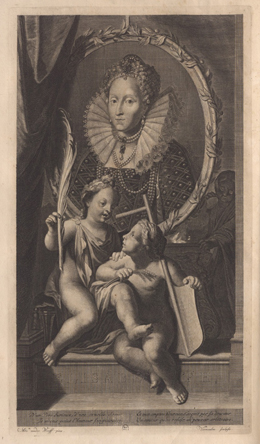
- The Vestal Flame Portrait of Elizabeth I
- The Natural Issue of her Majesty's Body
- The Affair of Thomas Seymour & Princess Elizabeth
- The Affair of Robert Dudley and Queen Elizabeth
- Queen Elizabeth I Pregnancy, Secret Marriage and Childbirth
- Sent from the Queen's Hand
- Hilliard Portrait of Francis Bacon
- Francis Bacon, born in the purple
- The Northumberland Manuscript
- The Royal Knight Sir Francis Bacon
- The Garter Knight Portrait of Francis Bacon
